Prince of Persia: The Sands of Time
The jewel in Ubisoft's Christmas crown.
In terms of third-person games, Prince of Persia is like first class air travel. You pay quite a lot for the privilege of eight hours' comfort at high altitudes, you have a merry old time sampling all the little luxuries and extravagances kept out of your reach in the rough and ready confines of economy, and although by the end of the journey you're still fairly content to depart the plane, remonstrating with yourself that it was a very expensive way to fly, given the choice it's a touch of class you'd certainly never be without. In other words, if the inconsistencies of titles like Spider-Man: The Movie, Legacy Of Kain and Tomb Raider left you with the gaming equivalent of deep vein thrombosis, Prince of Persia is like a gentle massage set to the peeling tones of a 72-virgin orchestra. It's spectacular and soothing to play.
Prince of Preconceptions
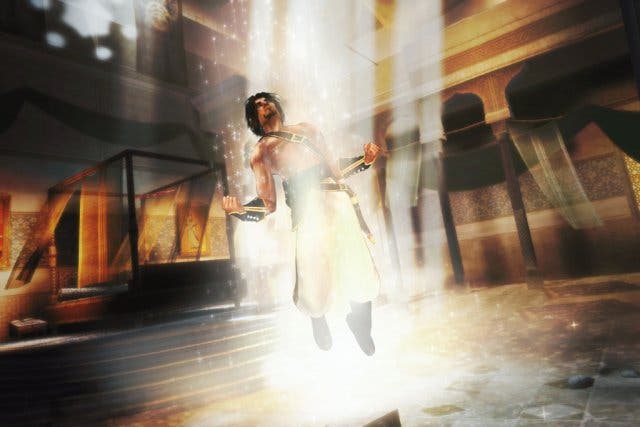
In fact, it almost seems unfair to call it a third-person action-adventure, because it's wonderfully inventive yet intuitive, logically designed and consistently rewarding without ever feeling contrived. Apart from ICO, which is probably the most directly comparable title on PS2 in terms of core gameplay, I can't think of a single third-person game that better fits the above description. As somebody who regularly has to suffer through and remain objective about the sort of cripplingly lame, soul-destroying misconstruction that runs throughout the genre, the beauty, simplicity and logic behind Prince of Persia is enough to bring a tear to my eye.
Quite simply, right from the start, almost everything about it feels right. The tone of the Prince's voice, the way he moves around the game's palatial labyrinth, the way he reacts to common gameplay scenarios (grasping a ledge at an angle, shimmying round corners, moving a box in any direction just by holding one side and using the analogue stick rather than having to run round it every time to push, etc), the way the combat fits in with the rest of the game, the way the puzzles are introduced, considered and solved, the placement of save points and foreshadowing of key game events through occasional 'visions' (it does work, trust me), and especially the Sands of Time angle, of which more shortly.
Prince of Persia, for the uninitiated, began life as a stylish platform adventure released during a time of archaic, slender and even unfinishable games, which had the player control a sword-swinging and acrobatic prince on a quest to rescue a damsel in distress. It was crude in some respects, but dazzlingly original and rewarding in others, and the decision to pit the player against an hourglass was sheer genius. Prince of Persia: The Sands of Time, which was reportedly only green-lit after creator and rights-holder Jordan Mechner personally okayed it, takes what made the original game good and translates it to 3D, making a smattering of its own intelligent decisions along the way. Basically you climb around massive 3D environments, running along walls and leaping between bars, ledges, chains, beams, platforms and even icy stalactites, occasionally pausing to take down a handful of cutthroat, reanimated former Persians or solve a logic puzzle, constantly basking in the glorious 3D landscape, and hoping eventually to undo the sins of the past.
Prince of Persia - but in 3D!
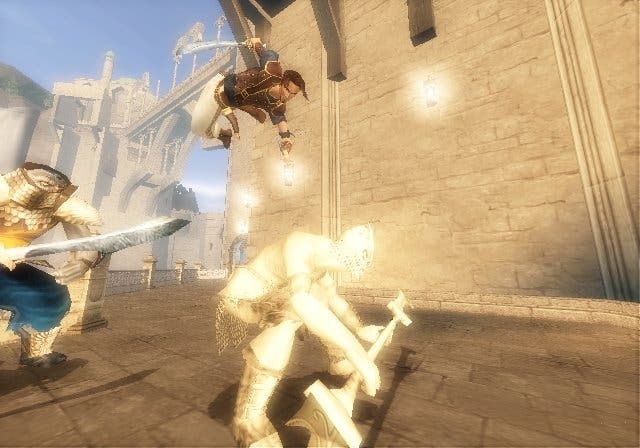
Obviously this has been tried before (the disappointing Prince of Persia 3D, for example), but the creative minds at Ubisoft Montreal have somehow defied third-person convention and married the charm and simplicity of the original to a more up-to-date style of game. Furthermore, instead of repeating the mistakes of the past, it has papered over as many of the cracks in the familiar third-person template as possible, leaving us with a satisfyingly complete and rarely unfair adventure that throws up far less "so I have to operate the cumbersome mechanics this way to progress" or "so I can't hang onto that piece of scenery and now I'm dead" scenarios than most games muster in an opening level alone. And when the game does do something you weren't expecting, it's quite literally not the end of the world.
Put it to any platform fan - heck, any gamer full stop - and they will agree that there are times in life when, as pause menus, restart options and reset buttons underscore the frustration of instant or unavoidable death, the most desirable thing in the world is an option to rewind the last few seconds and press a different button. Well, having looted a precious and mysterious dagger from the cavernous and well-defended underbelly of the Maharajah's palace, our princely protagonist quickly discovers he can do just that. As long as he has enough 'sands of time' stored up in his sand meter.
Although you can still 'die' and find yourself respawning at the last logical juncture (the start of a battle, the first of a sequence of platforms, the last save point, etc), by holding L1 the Prince's dagger literally rewinds events on-screen, allowing you to undo a mistimed jump, a fatal blow or whatever else conspires to thwart your progress. Obviously use is limited - your HUD has four sand notches initially, a number that grows proportionately as the game becomes more difficult, and each notch is worth one rewind, which can last up to around ten seconds. Strategically placed of piles of glowing sand allow you to top up your sand meter, as does the combat, in which the Prince draws sandy energy from downed foes by stabbing them with his mysterious dagger.
POP Idol
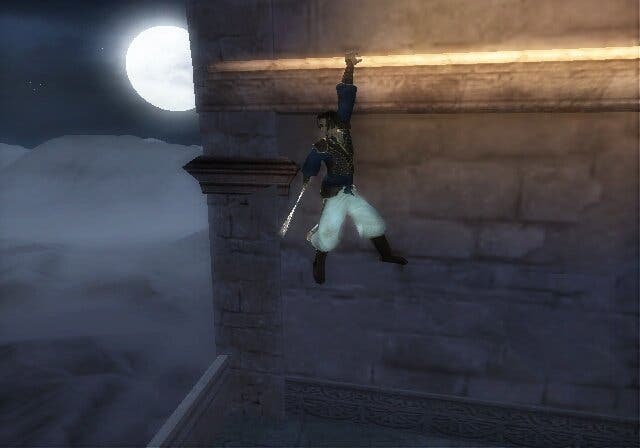
As with so much of the game, the balance here is just right. Although there will be times when, plagued by a crippling inability to figure out a route from point A to the enticing embrace of point B, you end up running out of sand, dying and having to reach for the Retry button - or not rewinding quite far enough and watching the same death unfold all over again - for the most part you're given enough to keep going and exhaust all your stupid and unworkable theories before figuring out the right way forward. During one particularly dense turn early on, for example, I'd just seen a balcony mostly demolished outside a small opening and couldn't for the life of me work out how to navigate around the confines of the main hall next door. Having unsuccessfully attempted several 'leaps of faith' and subsequently tumbled to my doom under several other flawed hypotheses, I went outside and realised I had to run along the wall using the R1 button and re-enter the hall on the other side of the crumbling remains of the balcony. Without The Sands of Time, who knows where I might have had to keep picking it up from, or whether I would have felt compelled to keep trying... Hang on. "Run along the wall"?
Yes. Another thing about Prince of Persia that helps it to stand out is the Prince's range of abilities, most of which are set in stone early on but never seem to grate. While other platformers and Tomb Raider-style adventures rely on crests, keys, cranks, inch-perfect jumps and a precognitive knowledge of booby traps, the Prince's style of exploration is more fluid, cartoon-like and invigorating, and I can think of hundreds of examples that play on different elements of his acrobatic skill-set - from the gymnastic swinging bar routines and ledge-shimmying/climbing antics to the tall columns that represent a safe climb to the ground, which can often only be reached by running along the wall and then springing off it as the Prince's feet patter over the column's precisely placed shadow.
And, most crucial to its charm, every time you want to do something logical, it is an option. It sounds like a silly little reviewer's justification, I know, but how many times have you tried to jump onto a ledge in a game only to fall off because you weren't running at the right angle? And how many times have you hung from a rope, bar or ledge and wanted to turn around and face the other way to make progress, only to find you can't because that's not the way a task was designed? This is no cop out - The Sands of Time is so thoroughly absorbing precisely because almost every eventuality is available to you. Need to go from one bar to the one directly above you? Then hurl yourself diagonally upward at a nearby wall and spring back towards the higher bar. Need to get to an adjacent narrow ledge? Just leap backwards. The Prince can cope. He's actually taken what ICO did so right and given it dialogue, greater depth and even subtler logic. Of course, it helps that every button on the pad responds exactly the way you want whenever you want, too.
Mountainous

The bulk of adventuring in POP is given over to these climbing frame-style palatial environments, then, and it's an almost indescribably alluring and rewarding experience to pick your way through them, which brought much hard-earned joy and satisfaction to your tearful correspondent, but then again that's not to say The Sands of Time isn't without its flaws, and one of the biggest is the combat system. But let's be clear. When I said "almost everything" in POP feels right all the way back up there, I should really have said "everything feels right to begin with," because the combat is one of a couple of things that start off so well and then lose out as the Prince makes progress. At first though, his acrobatic fighting style, based mainly around his cutlass-like sword that can be slashed around with the square button (and swapped for stronger blades at intervals), is energetic, full of stunning moves and super-heroically cinematic.
As the Prince squares up to an enemy, he can slash at them (though may be blocked), roll round the side of them and then slash (like Link in The Wind Waker) and even leap over their head and slice them from behind - the latter prompting plenty of gasping awe. Enemies obviously grow better at blocking the further you get and gang up on you (interesting side note: is there some sort of lunatic General Of Evil out there somewhere nefariously arranging underlings incrementally in terms of skill? And could the chairman of Liverpool FC please find and hire him immediately?), but individual duels generally end when an enemy is smashed to the ground, at which point the Prince can roll or jump over and stab them with his dagger (triangle) to draw their sand and prevent them regenerating.
But although there is some variation to be uncovered - like a move where the Prince springs off a wall to stab an enemy, and the various benefits of The Sands of Time, like slow motion - combat doesn't really evolve like the rest of the game. As soon becomes apparent, it's a fundamentally monotonous activity, whereas the adventuring isn't, because when that grows in terms of abilities - like being able to tiptoe along a tightrope-like beam or swing from a chain - it's a new tool to be cherished and experimented with all over the place, sometimes working in tandem with other techniques to previously untold effect. Combat, meanwhile, simply becomes a predictable routine, with new types of continuously spawning enemies doing little to flesh out the fundamental pantomime (and quite how this sort of respawn mechanic got into a game which almost rewrites the rulebook elsewhere is beyond me). It's passable, and it doesn't ruin the game or anything, but next to the high standards on display elsewhere it's a serious black mark.
POP eye in the sky

Continuing the theme of seemingly well-rounded ideas that quickly pale in comparison to the genius elsewhere, we have the third-person camera. I know - let's have a great big mammoth "will they ever get it right?" sigh for that one. But it does start out well enough - it moves relatively intelligently, you can invert it vertically and horizontally (though you can't alter the sensitivity), you can switch to an admittedly rather limited first-person view using R2 and, best of all, you can zoom out to a wider view using L2 - and still control the Prince - almost recalling the same 2D side-on gameplay as the first title. However things quickly become sloppy, and by the end of the game the camera is routinely getting caught on pillars, and in the game's more claustrophobic environments the L2 function is nowhere near as useful as it can be outside. Still, like the combat, it is a tolerable flaw and one that doesn't pervade the rest of the game with its sloppiness.
And to call the rest of the game anything other than a masterpiece would be ridiculous. It doesn't just do everything in the third-person genre right, it builds on the template and binds key new ideas to the Sands of Time premise masterfully - so much so in fact that it's going to be difficult for developers working on similar games to justify not borrowing everything that makes the game good. We've already dealt with how finely crafted and logically constructed an engine it is we're dealing with, but it's also important to note that it's an adventure where every room represents progress and something new, and everything is taken to its natural conclusion - with new moves regularly integrated in amongst the old guard effortlessly, puzzles growing in size and recalling earlier logic, and even the relationship with the Prince's female sidekick Farah regularly overhauled. She soon becomes key to progress, sneaking through narrow openings, hitting switches in time with the Prince and becoming important enough to protect and shepherd through the game's more violent and elaborate scenarios - and without the painfully nagging urgency when you're apart, something which frustrated more in ICO than perhaps we realised at the time.
Timeless?
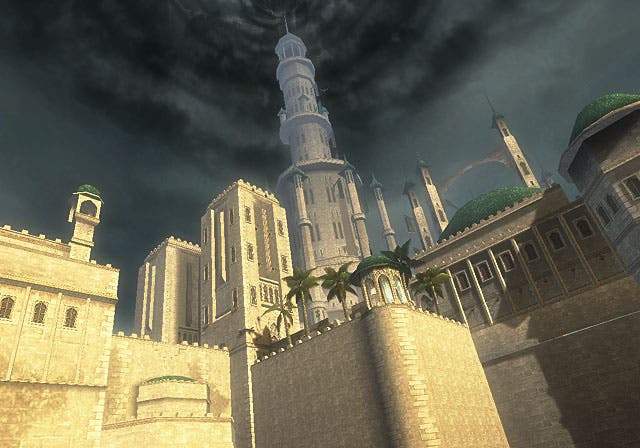
That's not to say POP is without urgency though - for a game spawned from a race-against-the-clock platformer that would be rather peculiar. In fact, POP changes tempo quite a lot, which keeps you on your toes. You may spend ages trying to scale the right sequence of platforms to make it to the top of a room, for example, only to flip a switch and have to descend rapidly to get to the slowly closing doorway halfway down. Good thing you know the way down fairly instinctively...
Logical placement of save points helps too, and the visions the Prince has at each of these intervals are a stroke of genius. Each offers a glimpse of significant events, perhaps introducing you to new ideas (the tightrope walk along narrow beams is something you'll only figure out how to do after witnessing it in a vision, for example) or giving you a clue as to how a puzzle might work, but they never fully solve a problem or make crucial mental leaps for you - they just inspire you to tackle the next room or puzzle, streamlining the experience without ruining it.
See, it's easy to categorise POP as a simple platform adventure with puzzles and swordfights, but if you do that then you have to acknowledge that it's a deceptively simple game that rarely bores you and throws up countless different scenarios, changing pace and challenging you to do different things without falling into too much of a routine. That's why you keep playing. One minute you're jumping around a bit like Lara Croft, swinging between bars like a circus act-cum-monkey and climbing along crumbling walls, the next you're trying to organise a series of mirrors to channel light in a particular direction, or timing a wall-running jump to dodge spinning mechanisms of death - or having to juggle all three. To rehash what I said in the first place, it's inventive yet intuitive, logically designed and consistently rewarding without ever feeling contrived.
Princely good looks
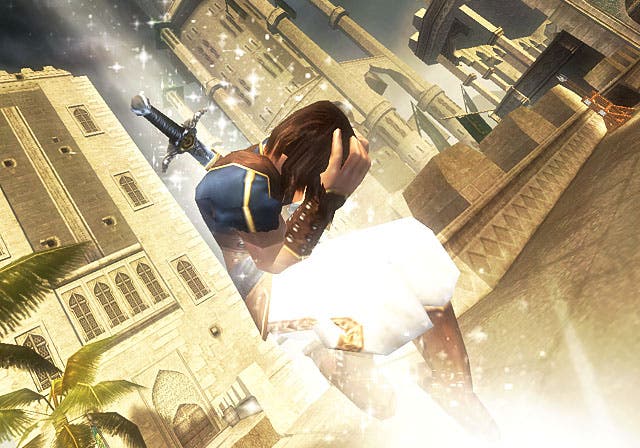
It helps that it's a beautiful game with an interesting (though hardly Oscar-worthy) plot and cast. The story is full of moral ambiguities which, sadly, aren't really worked out or considered at all, with more emphasis placed on the Prince's relationship with Farah, but it's still curious enough to keep you playing - as a proud son tries to please his father not as a warrior but as a courageous adventurer, only to wind up slaughtering most of his kingdom by accident.
The continuing story is told through FMV and some in-game cut-scenes, with well-spoken and sometimes amusing or poignant dialogue (as well as the usual "Why am I talking to myself?" and "She thinks this is a game!" sort of self-referential humour), but it's the environments that really steal the show, with huge and hugely detailed palatial surroundings that stretch in every direction, the same sort of hazy but gloriously bright visuals as ICO - only this time backed by little touches like Splinter Cell-esque lighting and material animation, and reflections and transparency effects that occasionally push the PS2 a little too hard.
Now, while the character models are emotive and the Prince vaguely iconic (he actually grows to resemble his forebear more with every tear on his shirt), it still looks ostensibly like a PS2 game, but there's something intangibly fresh about the game's artistic style. Our only complaints here are that there is no 60Hz mode (and the game is slightly bordered as a result), and that criminally there's no widescreen mode. As pampered little so-and-sos, we wouldn't normally bitch too loudly on that front, but Ubisoft did see fit to chuck in a progressive scan mode, so the absence of 16:9 - and in such an explorative sort of game, too - is lamentable.
Top of the POPs
Finally then we come to a couple of words that may well have dogged your thoughts since the second sentence of the introduction: "eight hours". I've seen play times quoted at more like 15 hours, but I can't honestly see it taking that long for anybody who's played this sort of game before. It's best to think of it somewhere in-between, I guess. 15 hours still isn't long though, particularly as it's the sort of game you won't be able to put down for long, but still beyond that I'm a bit stuck for what to do - the inclusion of the original Prince of Persia as an added bonus is a comforting reward, but you'd learn more about the process that gave us The Sands of Time by reading The Final Hours of Prince of Persia than you would watching the Making Of documentary. And although it's fun simply to play, it isn't the sort of game you would gain much from playing through several times.
With this in mind, a short justification for the figure gradually creeping into view is called for: right from the tutorial-minded prologue to the final slash, The Sands of Time is a towering achievement in far more areas than any other similar title. You've probably done a lot of the things you'll do in Prince of Persia before, but never to this standard, and apart from the innovations, the consistency, the logic and the spell-binding presentation, what makes it so special is just how well made it is. You may be paying more than makes sense for larger seats and more legroom, but like a back-massaging fully reclinable leather chair with a fridge in the arm, in the end it's worth every precious second.



